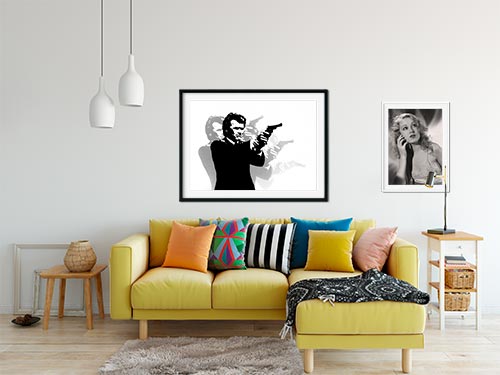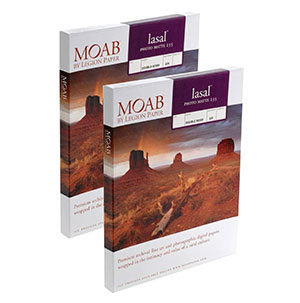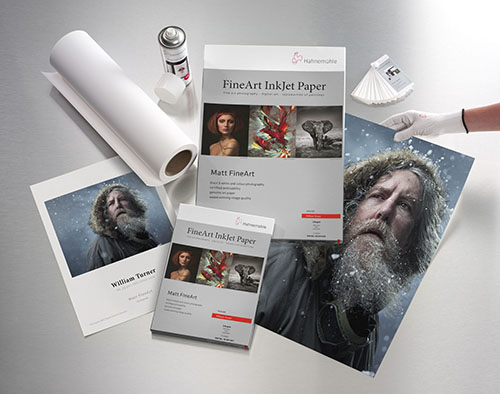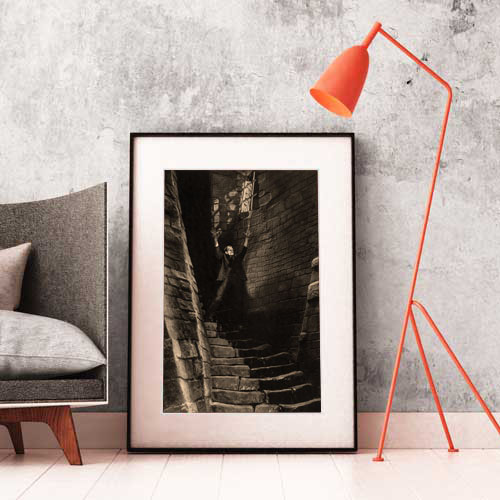Fantastic studio publicity shot featuring William Marshall (Prince Mamuwalde aka Blacula) about to put a second bite on the already bloody neck of Emily Yancy (Nancy).
Blacula is a 1972 American blaxploitation vampire horror film directed by William Crain. It stars William Marshall in the title role about an 18th-century African prince named Mamuwalde, who is turned into a vampire (and later locked in a coffin) by Count Dracula in the Count's castle in Transylvania in the year 1780 after Dracula refuses to help Mamuwalde suppress the slave trade. Blacula was released to mixed reviews in the United States, but was one of the top-grossing films of the year. It was the first film to receive an award for Best Horror Film at the Saturn Awards.
Blacula was followed by the sequel Scream Blacula Scream in 1973 and inspired a wave of blaxploitation-themed horror films. Many members of the cast and crew of Blacula had worked in television. Director William Crain had directed episodes of The Mod Squad. William H. Marshall's Mamuwalde was the first black vampire to appear in film. Marshall had previously worked in stage productions and in episodes of The Man from U.N.C.L.E., The Nurses, Bonanza, Star Trek and Mannix. Thalmus Rasulala, who plays Dr. Gordon Thomas, is best known for roles in episodes of The Twilight Zone, Perry Mason and Rawhide.
Blacula was in production between late January and late March 1972. While Blacula was in its production stages, William Marshall worked with the film producers to make sure his character had some dignity. His character name was changed from Andrew Brown to Mamuwalde and his character received a background story about being an African prince who had succumbed to vampirism. Blacula was shot on location in Los Angeles, with some scenes shot in Watts and the final scenes taken at the Hyperion Outfall Treatment Plant in Playa del Rey.
The music for Blacula is unlike that of most horror films as it features a funk soundtrack, as opposed to haunting classical music. The film's soundtrack features a score by Gene Page and contributions by the Hues Corporation and 21st Century Ltd. Blacula opened in Washington, Dallas, Seattle and Oklahoma City on August 25, 1972, and in Chicago two days later. Prior to its release, American International Pictures' marketing department wanted to ensure that black audiences would be interested in Blacula; some posters for the film included references to slavery. American International Pictures also held special promotional showings at two New York theaters; anyone wearing a flowing cape would receive free admission. Blacula was popular in America, debuting at #24 on Variety's list of top films. It eventually grossed over 1 million dollars, making it one of the highest-grossing films of 1972.
Product Enquiry
Kodak Professional Endura Paper
Kodak Endura papers provide an incredible amount of detail and smooth transition of tones. Designed for the professional photographer in mind, looking for a more traditional photo print style, Kodak Endura provides an extended print life and color gamut almost at the level of a high end fine art paper print.
Archival Matte Paper
Archival Matte Paper, also known as Moab Lasal Photo Matte, is our house stock fine art paper and is an economical favorite for fine art reproductions and photo prints. It features a smooth surface, heavy weight (230 g, 9.5-mil), neutral white, matte paper engineered for accurate color reproduction that provides high contrast and high-resolution output. This paper is acid-free, making it the perfect choice for both photography & fine art reproductions.
Giclee William Turner Paper by Hahnemühle
The William Turner by Hahnemühle is one of the most popular papers used in the Giclee printing industry. This is a 310g natural white mould made natural line paper with 100% rag content making it highly archival. It has a slight coarse texture which gives photos and artwork an elegant look. These fine art paper prints (also known as Giclee) are ordered by galleries, individual artists and photographers. The papers and inks are not only archival but use some of the most accurate print technology for full color prints.
- Giclee prints use very expensive archival pigmented inks.
- Highest level of color gamut available in printing (12 color printing).
- Exceptional black & white printing.
- Fade resistant, pigmented inks which provide a superior color range compared to other types of inks. Widely preferred in fine art and photography circles.
- We ONLY use professional grade fine art and photo paper that resist yellowing and aging.



Framing
We offer wood and metal frames, custom cut & joined to order. Each framed print includes hanging hardware and foamcore backer.
Matting
We use conservation grade 100% virgin alpha-cellulose 2 ply mats with white core. Acid-free and lignin-free, these are both face resistant and meet all conservation quality standards set by the Fine Art Trade Guild. Mats are digitally cut for ultimate precision. The window will be 1/8″ smaller than the print dimensions.
Glazing (Acrylic Glass)
We offer custom cut panes of shatter-proof, acrylic glass, to protect your valuable artwork and prints.
Premium Clear
Framing grade clear acrylic is shatter resistant and lightweight.
Reflection Control
With its matte finish, Tru Vue Reflection Control® Acrylic scatters light to diminish unwanted glare.
Conservation Clear
Tru Vue Conservation Clear® Acrylic is a framing industry staple, blocking up to 99% of UV rays for ultimate protection.
Conservation Reflection Control
Tru Vue Conservation Reflection Control® Acrylic scatters and diffuses light to reduce unwanted glare. Blocks up to 99% of UV rays.







